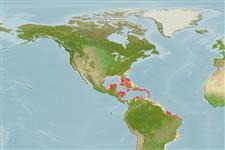>
Ovalentaria/misc (Various families in series Ovalentaria) >
Pomacentridae (Damselfishes) > Microspathodontinae
Etymology: Stegastes: Greek, stegastos, -e, -on = covered (Ref. 45335).
More on author: Cuvier.
Environment: milieu / climate zone / depth range / distribution range
Ökologie
seewasser riff-verbunden; standorttreu; tiefenbereich 1 - 30 m (Ref. 7247). Tropical
Western Atlantic: including southern Florida (USA), Bahamas, and the Caribbean Sea.
Size / Gewicht / Alter
Maturity: Lm ? range ? - ? cm
Max length : 13.0 cm TL Männchen/unbestimmt; (Ref. 26340)
Rückenflossenstacheln (insgesamt) : 12; Rückenflossenweichstrahlen (insgesamt) : 15 - 17; Afterflossenstacheln: 2; Afterflossenweichstrahlen: 13 - 14. Adults brownish gray with a yellowish cast; vertical dark lines following scale rows; a large blackish spot covering most of pectoral base, darkest near upper part; pectorals slightly dusky. The young are bright yellow with a large black spot at base of dorsal fin at junction of spinous and soft portions, a large black spot dorsally on caudal peduncle and a small one at upper pectoral base (Ref. 13442).
Adults inhabit inshore and offshore coral reefs. They are found within caves at night (Ref. 9626). Often found in tangles of staghorn coral; anywhere there is abundant algae on reefs (Ref. 26938). Feed mainly on algae but also on harpacticoid copepods, small gastropods, eggs of mollusks, sponges, polychaetes and hydroids (Ref. 9626). Juveniles subsist on the external parasites of fishes (Ref. 5521). Adults pugnaciously guard large territories, will chase and nip intruders of all sizes, including divers (Ref. 9710). Oviparous, distinct pairing during breeding (Ref. 205). Eggs are demersal and adhere to the substrate (Ref. 205). Males guard and aerate the eggs (Ref. 205). Taken incidentally in traps and small-meshed beach nets (Ref. 5217).
Life cycle and mating behavior
Maturities | Fortpflanzung | Spawnings | Egg(s) | Fecundities | Larven
Oviparous, distinct pairing during breeding (Ref. 205). Eggs are demersal and adhere to the substrate (Ref. 205). Males guard and aerate the eggs (Ref. 205).
Allen, G.R., 1991. Damselfishes of the world. Mergus Publishers, Melle, Germany. 271 p. (Ref. 7247)
IUCN Rote Liste Status (Ref. 130435)
Bedrohung für Menschen
Harmless
Nutzung durch Menschen
Fischereien: kommerziell; Aquarium: Kommerziell
Tools
Zusatzinformationen
Download XML
Internet Quellen
Estimates based on models
Preferred temperature (Ref.
123201): 25.6 - 28.2, mean 27.4 °C (based on 672 cells).
Phylogenetic diversity index (Ref.
82804): PD
50 = 0.5000 [Uniqueness, from 0.5 = low to 2.0 = high].
Bayesian length-weight: a=0.02042 (0.01172 - 0.03557), b=2.97 (2.82 - 3.12), in cm total length, based on LWR estimates for this species & Genus-body shape (Ref.
93245).
Trophic level (Ref.
69278): 3.3 ±0.3 se; based on diet studies.
Generation time: 3.3 ( na - na) years. Estimated as median ln(3)/K based on 2
growth studies.
Widerstandsfähigkeit (Ref.
120179): hoch, Verdopplung der Population dauert weniger als 15 Monate. (K=0.33-0.58).
Fishing Vulnerability (Ref.
59153): Low vulnerability (24 of 100).
Nutrients (Ref.
124155): Calcium = 96.4 [49.3, 151.3] mg/100g; Iron = 0.71 [0.42, 1.14] mg/100g; Protein = 18.5 [17.4, 19.6] %; Omega3 = 0.12 [0.07, 0.19] g/100g; Selenium = 24.3 [13.9, 44.1] μg/100g; VitaminA = 88.4 [26.4, 283.0] μg/100g; Zinc = 1.47 [1.00, 2.10] mg/100g (wet weight);
